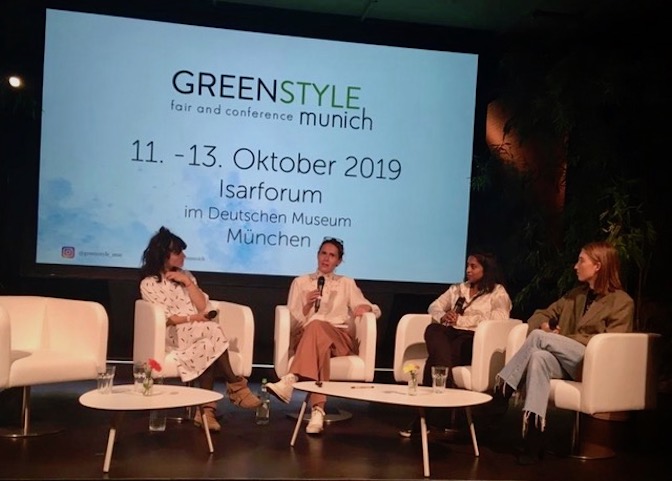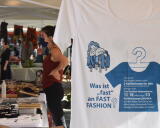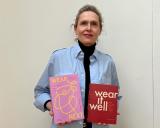Fashion + Design > Fashion
October 16, 2019
Wonder Wardrobe? Daria Andronescu weiß Bescheid
Susanne Barta
Daria Andronescu ist Imageberaterin, Personal Shopperin und Gründerin der „Wonder Wardrobe online Video Kurse“. Ich bin auf sie über Youtube gestoßen. Die gebürtige Russin lebt in Düsseldorf, hat ihr eigenes „Capsule wardrobe system“ entwickelt und bildet Interessierte aus, wie sie zu einer funktionierenden, persönlichen und nachhaltigen Garderobe kommen. Das Konzept der „Capsule wardrobe“ ist aus dem Minimalismus-Gedanken heraus entstanden und hilft gegen überfüllte Kleiderschränke, Shoppingwahn und Fast Fashion. Dabei wird der Kleiderschrank so optimiert, dass am Ende nur eine bestimmte Anzahl an Kleidungsstücken übrigbleiben, die gefallen, gut kombinierbar sind und möglichst viele Outfits ergeben.
Everybody talks about Capsule wardrobes, Daria. How do you define it?
A Capsule wardrobe is a collection of a few essential items of clothing, it is small by definition and gives you limited options. I actually don’t do Capsule wardrobes, I just took the concept, worked on it and made it more adaptable to everyday life. The classic Capsule wardrobe has about ten items, that’s not practical. We are used to having many options, are often distracted by them and used to having new things all the time. The concept simply doesn’t solve the problem of impulse buying, which is a big problem nowadays. This is why I created “Wonder Wardrobe“, which is based on the Capsule wardrobe concept, but can include as many items as you need. For some people a small wardrobe works, others need more. But they still want a functional and interchangeable wardrobe without overbuying.
What can people learn @ Wonder Wardrobe?
They start with analysing their lifestyle. You have different activities in your life and need different outfits for that. By understanding your lifestyle, you can better understand how many outfits you need. It’s less important how many items you have, but more how many outfits you can create. And how many you actually like to wear. “Wonder Wardrobe“ allows you to have different outfits for different occasions that suit your lifestyle.
“At the end of this process“, I read on your blog, “is a personal, multifunctional, well-organised wardrobe containing an ideal amount of beautiful, fully interchangeable outfits that reduce waste and support sustainable fashion brands“. Is it a lot of work to achieve this?
It takes some work, yes. I never say it’s an easy thing to do, it’s a process. You should take some time for the transition. What I see from my students is that it takes about a month to reorganise what you already have. And then step by step you build up by adding a few items per season till you have your fully interchangeable wardrobe.
We are bombarded with trends. I guess it also takes some effort to find your personal style?
As an image consultant that’s my specialty. I have identified five different fashion personalities, the hardest part is to find the one you fit into. You learn about this in the “Wonder Wardrobe“ course. I divide all clothes into elements. Some clothes are more romantic, others dramatic, some more casual, others more sexy. People learn how to read clothing, to understand these elements. It’s not so complicated, it’s also a lot of fun. A lot more difficult is finding your colours and the right and best fit. We see all these beautiful models, these unrealistic standards and that makes everyone very confused.
Tell us about your personal approach to sustainable fashion, how did it start?
I worked as a consultant and personal shopper and helped people to understand what’s the best image for them, their lifestyle and their status. And then guided them to create a wardrobe. I went to their homes and saw what they buy and how they treat their stuff. After four years of doing this I realized, people have no idea what they are buying, how much money they are spending on clothing, they didn’t know what fits them, they are completely lost. They buy a lot on impulse and the piles of not worn clothes are growing. I also hold a Master Degree in Environmental Law, so with this background, I thought it is probably time to use my styling experience for teaching people how not to overbuy. No matter how much money people have and what they do in life, they all buy and throw away too much.

Clothes are little valued today. As you said we buy and throw away too much. Do we have to change our consumption habits?
We have to, we have no choice. But of course, it takes time. Clothing is too cheap nowadays, cheaper than your lunch sometimes, that’s the problem. Even if you tell people how it was made, how bad the materials are for you and the planet, they don’t pay very much attention because the investment seems so little. We need to educate people and try to find ways that they can learn. Fashion is fun, it’s irrational, which doesn’t make it easy.
Is the industry changing in your opinion? Fast enough?
The change is very slow.
Too much talking, not enough actions?
I started “Wonder Wardrobe“ three years ago. I don’t see much change in these years. Some new sustainable brands, yes, but they can’t compete with the fast fashion monsters. There is a lot of greenwashing, people get confused. They see eco and think it’s ok, but very often it’s not.
On your blog one can learn a lot about the industry, about materials and their environmental impact. Education is your main focus nowadays?
Yes, I switched from working person to person to a broader online audience.
Do you experience that more people are interested?
I can see that. With “Wonder Wardrobe“ we don’t judge, never preach, just give the facts, maybe plant a seed. We can’t force people. It’s very important to have a conversation. “Don’t go to Zara“ doesn’t work. And if you go to Zara try to choose better, things that last longer. And when you are ready we tell you what brands are doing better, where you can go and tell you more about materials, how the industry works etc.
How do you perceive the role of influencers, of social media? I remember one of my first inspirations was the Danish blogger Signe Hansen…
Influencers and bloggers are important. I never thought about myself as an influencer, more of an educator. Signe for example doesn’t teach but shows how you can love and care for your clothes, style them and not getting bored.
Both of you have a very gentle approach…
If you scream at people they just run away. And feeling guilty leads nowhere.
Do you have a tip for the first step to becoming a more conscious fashion consumer?
To buy less and if you buy choose better. Clothes that last longer and don’t hurt other people. Buying less sounds simple but it’s not. Some students really suffer from impulse shopping. So I ask them what else they want to do, what else they like and feel good about, what else they want to invest in? There is so much more than clothes. I think all of us should be more responsible for our actions. We like to justify our choices and this sometimes stops us from making better decisions with less negative impact. We should all be more reasonable and more practical about fashion.
Ich bin gerade zurück gekommen aus München von der nachhaltigen Mode-Messe und Konferenz Greenstyle, wo auch „Capsule Wardrobe“ mehrfach Thema war. Unter anderem wurde die junge Initiative „Fairnica“, vorgestellt, wo Kapseln gemietet werden können für eine bestimmte Zeit. Ein tolles Projekt. Das „Wonder Wardrobe System“ habe ich noch nicht ausprobiert, aber vielleicht gehe ich das mal an. Mein Schrank ist jedenfalls strukturierter als früher, ich mag das meiste, das drin hängt, und ich lasse mich inspirieren von Menschen wie Daria.

Fotos: (1) + (2) Daria Andronescu; (3) Susanne (Hose > Arket; Bluse > Secondhand, Sneakers > Allstars) moderiert die Gesprächsrunde auf der Greenstyle München über Alternativen zum Konsum mit Balini von Fairnica, Hannah von „The Renewery“ und Secondhand-Expertin Melanie Leyendecker.


















Comments